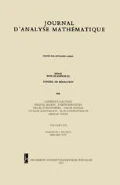Abstract
We define a hierarchy of systems with topological completely positive entropy in the context of countable amenable continuous group actions on compact metric spaces. For each countable ordinal we construct a dynamical system on the corresponding level of the aforementioned hierarchy and provide subshifts of finite type for the first three levels. We give necessary and sufficient conditions for entropy pairs by means of the asymptotic relation on systems with the pseudo-orbit tracing property, and thus create a bridge between a result by Pavlov and a result by Meyerovitch. As a corollary, we answer negatively an open question by Pavlov regarding necessary conditions for completely positive entropy.
Similar content being viewed by others
References
E. Akin, The General Topology of Dynamical Systems, American Mathematical Society, Providence, RI, 2010.
F. Blanchard, B. Host, and S. Ruette, Asymptotic pairs in positive-entropy systems, Ergodic Theory Dynam. Systems 22 (2002), 671–686.
F. Blanchard, Fully positive topological entropy and topological mixing, in Symbolic Dynamics and its Applications, American Mathematical Society, Providence, RI, 1992, pp. 95–105.
F. Blanchard, A disjointness theorem involving topological entropy, Bull. Soc. Math. France 121 (1993), 465–478.
R. Bowen, On Axiom A Diffeomorphisms, American Mathematical Society, Providence, RI, 1978.
N.-P. Chung and H. Li, Homoclinic groups, IE groups, and expansive algebraic actions, Invent. Math. 199 (2014), 805–858.
N.-P. Chung and K. Lee, Topological stability and pseudo-orbit tracing property of group actions, Proc. Amer. Math. Soc. 146 (2017), 1047–1057.
T. Downarowicz and Y. Lacroix, Topological entropy zero and asymptotic pairs, Israel J. Math. 189 (2011), 323–336.
E. Glasner and X. Ye, Local entropy theory, Ergodic Theory Dynam. Systems 29 (2009), 321–356.
W. Huang, L. Xu, and Y. Yi, Asymptotic pairs, stable sets and chaos in positive entropy systems, J. Funct. Anal. 268 (2015), 824–846.
D. Kerr and H. Li, Independence in topological and C*-dynamics, Math. Ann. 338 (2007), 869–926.
D. Kerr and H. Li, Ergodic Theory, Springer, Berlin, 2016.
E. Lindenstrauss, Pointwise theorems for amenable groups, Invent. Math. 146 (2001), 259–295.
D. Lind and K. Schmidt, Homoclinic points of algebraic ℤd-actions, J. Amer. Math. Soc. 12 (1999), 953–980.
T. Meyerovitch, Pseudo-orbit tracing and algebraic actions of countable amenable groups, Ergodic Theory Dynam. Systems 39 (2019), 2570–2591.
P. Oprocha, Shadowing in multi-dimensional shift spaces, Colloq. Math. 110 (2008), 451–460.
R. Pavlov. A characterization of topologically completely positive entropy for shifts of finite type, Ergodic Theory Dynam. Systems 34 (2013), 2054–2065.
R. Pavlov, Topologically completely positive entropy and zero-dimensional topologically completely positive entropy, Ergodic Theory Dynam. Systems 38 (2018), 1894–1922.
V. A. Rohlin and Y. Sinai, The structure and properties of invariant measurable partitions, Dokl. Akad. Nauk SSSR 141 (1961), 1038–1041.
V. Salo, Entropy pair realization, arXiv:1904.01285 [math.DS]
K. Schmidt, The cohomology of higher-dimensional shifts of finite type, Pacific J. Math. 170 (1995), 237–269.
A. Shulman, Maximal ergodic theorems on groups, Dep. Lit. NIINTI 2184 (1988), no. 114.
B. Song and X. Ye, A minimal completely positive entropy non-uniformly positive entropy example, J. Difference Equ. Appl. 15 (2009), 87–95.
P. Walters, On the pseudo orbit tracing property and its relationship to stability, in The Structure of Attractors in Dynamical Systems, Springer, Berlin-Heidelberg, 1978, pp. 231–244.
L. B. Westrick, Topological completely positive entropy is no simpler in F2-sfis, arXiv:1904.11444 [math.DS]
Acknowledgments
We thank Nishant Chandgotia for very helpful remarks and prolific discussions concerning this work, and Hanfeng Li for valuable comments on an earlier draft. We are also grateful to anonymous referees for their valuable comments. We also wish to thank PIMS for their support. This research was partially supported by the FONDECYT grant 11200037, ANR projects CoCoGro (ANR-16-CE40-0005) and CODYS (ANR-18-CE40-0007), NSERC (PDF-487919) and CONACyT (287764).
Author information
Authors and Affiliations
Corresponding author
Rights and permissions
About this article
Cite this article
Barbieri, S., García-Ramos, F. A hierarchy of topological systems with completely positive entropy. JAMA 143, 639–680 (2021). https://doi.org/10.1007/s11854-021-0167-2
Received:
Revised:
Published:
Issue Date:
DOI: https://doi.org/10.1007/s11854-021-0167-2




